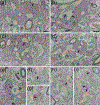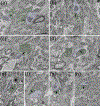Ultrastructure of ipsilateral and contralateral tectopulvinar projections in the mouse
- PMID: 34636423
- PMCID: PMC8957504
- DOI: 10.1002/cne.25264
Ultrastructure of ipsilateral and contralateral tectopulvinar projections in the mouse
Abstract
Visual pathways of the brain are organized into parallel channels that code different features of the external environment. In the current study, we investigated the anatomical organization of parallel pathways from the superior colliculus (SC) to the pulvinar nucleus in the mouse. Virus injections placed in the ipsilateral and contralateral SC to induce the expression of different fluorescent proteins define two pulvinar zones. The lateral pulvinar (Pl) receives ipsilateral SC input and the caudal medial pulvinar (Pcm) receives bilateral SC input. To examine the ultrastructure of these projections using transmission electron microscopy, we injected the SC with viruses to induce peroxidase expression within synaptic vesicles or mitochondria. We quantitatively compared the sizes of ipsilateral and contralateral tectopulvinar terminals and their postsynaptic dendrites, as well as the sizes of the overall population of synaptic terminals and their postsynaptic dendrites in the Pl and Pcm. Our ultrastructural analysis revealed that ipsilateral tectopulvinar terminals are significantly larger than contralateral tectopulvinar terminals. In particular, the ipsilateral tectopulvinar projection includes a subset of large terminals (≥ 1 μm2 ) that envelop dendritic protrusions of postsynaptic dendrites. We also found that both ipsilateral and contralateral tectopulvinar terminals are significantly larger than the overall population of synaptic terminals in both the Pl and Pcm. Thus, the ipsilateral tectopulvinar projection is structurally distinct from the bilateral tectopulvinar pathway, but both tectopulvinar channels may be considered the primary or "driving" input to the Pl and Pcm.
Keywords: electron microscopy; pulvinar; superior colliculus; synapse; vesicle; widefield vertical.
© 2021 Wiley Periodicals LLC.
Conflict of interest statement
Figures






References
Publication types
MeSH terms
Grants and funding
LinkOut - more resources
Full Text Sources
Molecular Biology Databases
Research Materials

